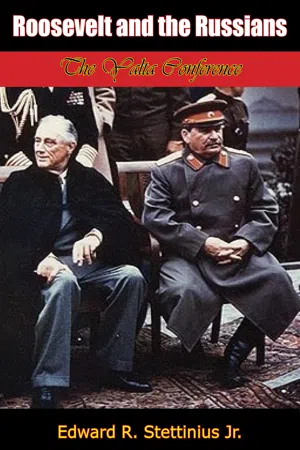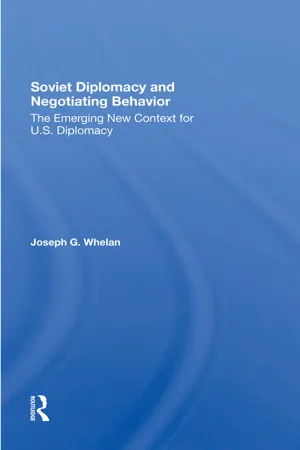History
Yalta Conference
The Yalta Conference was a meeting held in February 1945 between the leaders of the United States, the Soviet Union, and the United Kingdom. The conference aimed to discuss the post-World War II reorganization of Europe and the establishment of the United Nations. Key decisions made at Yalta included the division of Germany and the commitment to hold free elections in Eastern European countries.
Written by Perlego with AI-assistance
Related key terms
3 Key excerpts on "Yalta Conference"
- eBook - ePub
Roosevelt and the Russians
The Yalta Conference
- Edward R. Stettinius Jr.(Author)
- 2017(Publication Date)
- Eschenburg Press(Publisher)
PART ONE—TRYING TO BUILD A BETTER WORLD
CHAPTER 1—Background of the Yalta Conference
The Yalta Conference—February 4–11, 1945—was the most important wartime meeting of the leaders of Great Britain, the Soviet Union, and the United States. It was not only the longest meeting of President Roosevelt with Prime Minister Churchill and Marshal Stalin; it was also the first time that the three leaders reached fundamental agreements on post-war problems as distinct from mere statements of aims and purposes. Many problems of a non-military nature had been discussed at Teheran, but basic agreements were not reached or even attempted.This was the second time the three war leaders had met, but it was the first occasion on which they had met with all their foreign ministers. Although Anthony Eden and V. M. Molotov had participated in the Teheran Conference—November 28–December 1, 1943—Cordell Hull had not.The Yalta Conference, too, was the first real occasion on which the Chiefs of Staff of the three countries conducted an exhaustive examination of the respective military positions of the Allied forces and discussed in detail their future plans. The timing of the second front and related military questions had been discussed at Teheran, but it was not until Yalta that sufficient confidence existed among the three nations for a free and open examination of future operational plans.Thus the Yalta Conference marked the high tide of British, Russian, and American co-operation on the war and on the post-war settlement. In the days immediately after the Conference most American newspapers gave high praise to what had been accomplished in the Crimea. - eBook - ePub
- Jerald A Combs(Author)
- 2017(Publication Date)
- Routledge(Publisher)
Hurley was an ignorant blusterer who arrived in China wearing an army uniform adorned with every campaign ribbon except that for Shays’s Rebellion, according to one observer. He failed totally to overcome the resistance of Chiang and Mao to a coalition. With Hurley’s failure, Roosevelt turned to Stalin in the hope that he would force Mao to accept a subsidiary position in a coalition with Chiang.The Yalta Conference: February 1945
Roosevelt, Churchill, and Stalin arranged to meet at the Russian resort town of Yalta in the Crimea. Each came with a separate agenda of priorities. Roosevelt wanted Stalin to help defeat Japan and push Mao toward a coalition with Chiang Kai-shek. Roosevelt knew he had to agree to a settlement in Poland that would provide a regime friendly to Stalin because Russian troops occupied the country, but he still hoped to salvage something of the Poles’ right to self-determination. He wanted similar settlements in the rest of Eastern Europe, but these were of less public interest to the West. Most important, Roosevelt, having abandoned the Morgenthau plan completely, wanted an agreement on Germany that would permit it to remain strong enough economically to contribute to Europe’s recovery and prosperity. In addition, he had accepted Churchill’s argument that France should regain its position as a great power. He was ready to support France’s position as a permanent member of the United Nations Security Council with a veto and to give France an area of occupation in Germany.At Yalta, he would also abandon his attempts to dismantle the French Empire. Under pressure from Churchill, who had the fate of the British Empire in mind, Roosevelt would agree that the United Nations should be given trusteeships only over colonies of the defeated Axis powers, not over any colonies of the Allies. Thus, Roosevelt was ready to permit the French to reassume their control of Indochina once the Japanese were defeated. Finally, Roosevelt wanted to maintain cordial relations with the Soviet Union and keep it engaged with the United States in a United Nations that would be attractive to American public opinion. - eBook - ePub
Soviet Diplomacy And Negotiating Behavior
The Emerging New Context For U.s. Diplomacy
- Joseph G. Whelan(Author)
- 2019(Publication Date)
- Routledge(Publisher)
195Informality was also a marked characteristic as the Conference took on the style most favored by the President.196 And despite pressures and counterpressures of negotiations, a cooperative spirit seemed to prevail.197 Accounts of the Conference, such as Eden's, convey the general feeling of a traditional negotiating environment with expected tensions in the give-and-take of negotiations as the participants sought to achieve their own purposes. Tough and complex issues were resolved, often according to existing power realities; some were only discussed; others were deferred.That a generally favorable spirit prevailed at the proceedings was perhaps most evident by the hopeful expectations reflected in the attitudes of the participants upon leaving Yalta for home. Yet the cordiality of the Conference was counterbalanced by the seriousness of its business. As Bohlen recorded, "Underneath this gloss of goodwill, the three leaders were waging a fierce struggle on the shape of the postwar world."198(2 ) Aspects of Conference support and organization(a ) Procedure and agenda: Order and confusion.At Yalta, there was both order and confusion. A strong advocate of informality in international negotiations, President Roosevelt set the stage when he proposed at the opening first plenary session on February 4, which he chaired, that the talks be conducted, in the words of Bohlen's minutes, "in an informal manner in which each would speak his mind frankly and freely, since he had discovered through experience that the best way to conduct business expeditiously was through frank and free speaking."199Organizationally, Yalta was a multilevel conference with many sessions going on often simultaneously among the military chiefs, the Foreign Ministers and the Heads of State. In addition, business was carried on at luncheons and dinners and at private meetings between any of the leaders. Plenary sessions were held every day at 4 p.m. and meetings of the Foreign Ministers and military chiefs every morning.200
Learn about this page
Index pages curate the most relevant extracts from our library of academic textbooks. They’ve been created using an in-house natural language model (NLM), each adding context and meaning to key research topics.


